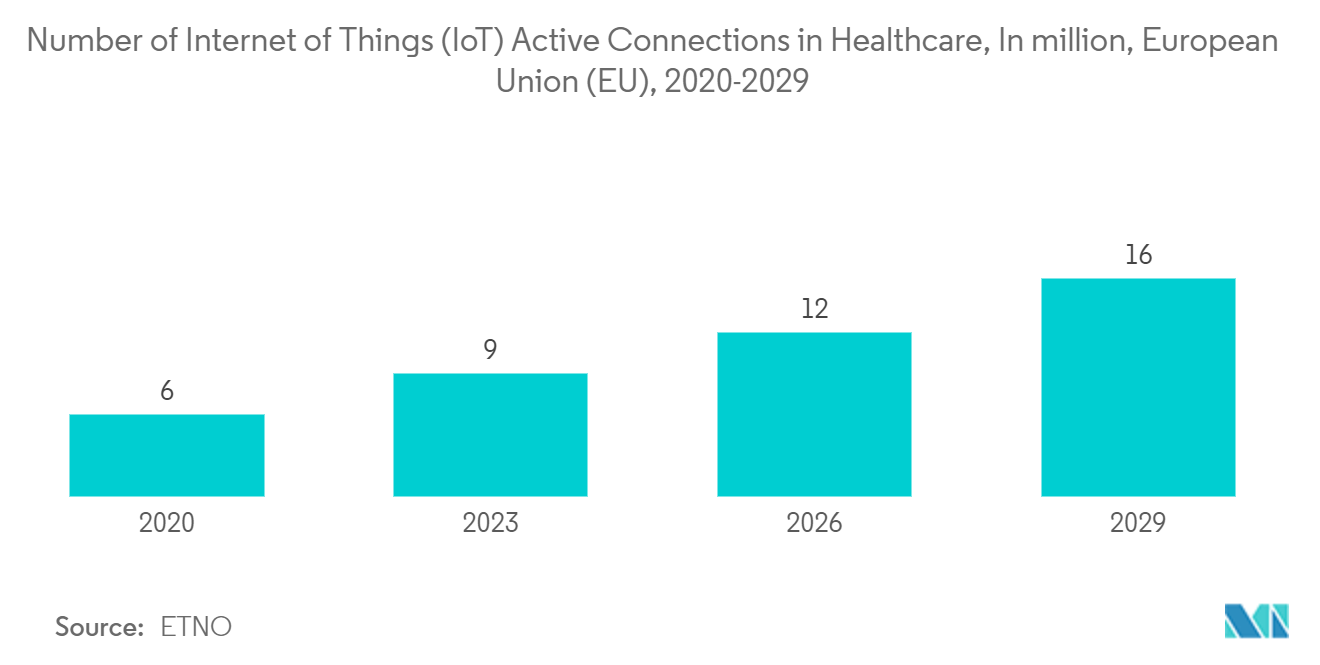Market Trends of Internet Of Things (IoT) Platform Industry
Medical End-User Industry is Expected to Witness Significant Growth
- According to the BICS SA/NV, connected medical devices are expected to represent 40% of all IoT technology, transforming the industry by building an enhanced patient experience with easy-to-deploy monitoring and reporting proficiencies.
- A worldwide shortage of healthcare workers is a significant concern for the industry. In the United States alone, the shortage is projected at 124,000 physicians in the coming three years. Although it is lower than the anticipated shortages in Asia and Africa, it still signifies a crucial deficiency. This factor indicates a need for upgraded medical facilities and rapid growth in the healthcare sector, which may further drive the market. Advanced and connected medical equipment are more likely to experience demand.
- Lifestyle disease management applications involving IoT are still at a nascent stage and are costly. Ordinary consumers generally need to experience these services. This creates an opportunity for vendors serving such consumer segments.
- Only a few industries require such careful timing of responses as hospitals do. Life and death circumstances frequently need quick thinking, obtaining the appropriate supplies or medications, and knowing which doctor is accessible and where to reach him. Hospital staff can now track the whereabouts of medical equipment, the quantity of supplies, and the whereabouts of their coworkers in real-time, thanks to the use of IoT. Infections within the hospital can be avoided, and a consistently high degree of hygiene can be maintained.
- For instance, the previous year, Olea Sensor Networks announced the OSN Digital Health Platform at CES the same year, based on Olea's next-gen system for contactless and remote vital sign monitoring of OleaSense. The digital health development platform for IoT product development and advanced research processes real-time data using Olea's AI signal processing and peak detection algorithms, extracting vital statistics such as cardiac, respiration, and heart-rate variability.
- According to Ericsson report, Nearly 60% of cellular IoT connections are anticipated to be broadband connections by the end of 2028, with 4G connecting the vast majority. Throughput data rates will significantly rise as 5G New Radio (NR) is implemented in both existing and new airwaves. To promote innovations in IoT applications, enabling technologies is an essential need for the healthcare sector. The implementation of IoT-based healthcare systems is based on big data collected from hospitals, rehabilitation centers, communities, and homes. The gathered data updates in real-time, and the data transactions may happen simultaneously among the connected things. Information can be stored on the servers.

North America is Expected to Hold Significant Market Share
- According to GSMA Intelligence, it is anticipated that there will be 5.4 billion Internet of Things (IoT) connections overall in North America in the coming three years. In North America, there were 2.8 billion Internet of Things connections. In order to promote operational efficiency and boost competitiveness, IoT adoption is driven by organizations; however, in the area, IoT adoption is driven by the desire to save costs. An Ovum survey found that American businesses frequently used IoT to cut costs.
- IoT is a rapidly growing industry in the United States. Modern manufacturing facilities in the US rely on new technologies and innovations for producing higher quality products at an enhanced rate with lower costs. According to the Consumer Technology Association, based on prior to the previous year, the connected device shipments were 791 million units in the United States.
- IoT technologies are overcoming the labor shortage in the manufacturing sector, especially in developed countries like the United States. Due to this, the Federal Government and the private sector in the United States are investing in Industry 4.0 IoT technologies to increase the American industrial base, which China and other low-labor cost countries have taken over. Therefore, IoT technologies may mainly drive the adoption of smart factory solutions across the region.
- To meet the dynamic demands of the customers and enhance their product portfolio, the companies are incorporating new features in existing products and developing new products. For instance, prior to the previous year, Ayla Networks, a player in the Internet of Things (IoT) platforms that speed up digital transformation for consumer brands and Internet service providers (ISPs), announced that Canadian Tire, a member of the Canadian Tire Corporation group of companies with over 500 stores across Canada, selected its turnkey IoT firmware to power a new, globally available line of smart home products.
- Furthermore, in last year, New internet of Things (IoT) solutions for smart cities and smart buildings were introduced by Rogers Business, the part of Rogers Communications that focuses on businesses. These new solutions from diverse Rogers partners increase response and efficiency in water, parking, traffic, transit, and fleet management, expanding Rogers' current IoT portfolio. Advanced technology in air quality, security, and digital signage systems have also been included in new smart building solutions.

